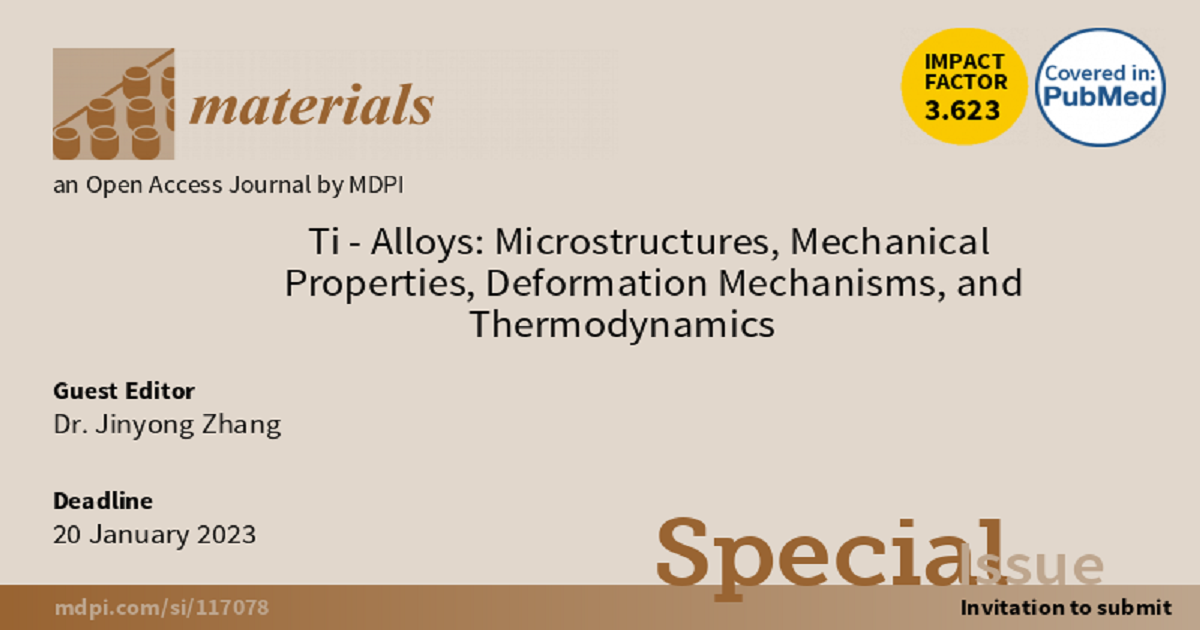Ti-Alloys: Microstructures, Mechanical Properties, Deformation Mechanisms, and Thermodynamics
A special issue of Materials (ISSN 1996-1944). This special issue belongs to the section "Metals and Alloys".
Deadline for manuscript submissions: closed (20 January 2023) | Viewed by 5094

Special Issue Editor
Special Issue Information
Dear Colleagues,
As we all know, Ti and Ti-alloys offer a wide range of properties such as high strength, low density, biocompatibility, and good corrosion resistance. These properties are unique advantages for Ti-alloys to be used in various engineering fields, such as the aerospace, biomedical, automotive, and oil and gas industries.
At present, all countries are developing new Ti-alloys with low cost and high performance, and strive to make Ti-alloys enter the civilian industrial field with huge market potential. New applications of Ti-alloys require significant improvements in their physical and mechanical properties, which can be achieved through the use of new technologies (especially laser processing, additive manufacturing, nanotechnology, etc.). Traditionally, alloy design is based on the foundations of physical metallurgy, in particular a deep understanding of structural evolution and structure-property relationships. On the other hand, the rapid development of digital technologies has enabled intelligent engineering and design systems (eg, finite element simulations, neural networks and artificial intelligence, thermodynamic calculations) to play a greater role in the development of advanced materials and technologies.
This Special Issue of Materials aims to present recent original research on the design, mechanical properties and micromechanisms of Ti-alloys. The scope includes microstructures, mechanical properties, deformation mechanisms, and thermodynamics of Ti-alloys.
Dr. Jinyong Zhang
Guest Editor
Manuscript Submission Information
Manuscripts should be submitted online at www.mdpi.com by registering and logging in to this website. Once you are registered, click here to go to the submission form. Manuscripts can be submitted until the deadline. All submissions that pass pre-check are peer-reviewed. Accepted papers will be published continuously in the journal (as soon as accepted) and will be listed together on the special issue website. Research articles, review articles as well as short communications are invited. For planned papers, a title and short abstract (about 250 words) can be sent to the Editorial Office for assessment.
Submitted manuscripts should not have been published previously, nor be under consideration for publication elsewhere (except conference proceedings papers). All manuscripts are thoroughly refereed through a single-blind peer-review process. A guide for authors and other relevant information for submission of manuscripts is available on the Instructions for Authors page. Materials is an international peer-reviewed open access semimonthly journal published by MDPI.
Please visit the Instructions for Authors page before submitting a manuscript. The Article Processing Charge (APC) for publication in this open access journal is 2600 CHF (Swiss Francs). Submitted papers should be well formatted and use good English. Authors may use MDPI's English editing service prior to publication or during author revisions.
Keywords
Ti Alloys;
Microstructure;
Mechanical Properties;
Deformation Mechanisms;
Thermodynamics;
Alloy Design;
Simulations;
Phase Transformation.
Benefits of Publishing in a Special Issue
- Ease of navigation: Grouping papers by topic helps scholars navigate broad scope journals more efficiently.
- Greater discoverability: Special Issues support the reach and impact of scientific research. Articles in Special Issues are more discoverable and cited more frequently.
- Expansion of research network: Special Issues facilitate connections among authors, fostering scientific collaborations.
- External promotion: Articles in Special Issues are often promoted through the journal's social media, increasing their visibility.
- Reprint: MDPI Books provides the opportunity to republish successful Special Issues in book format, both online and in print.
Further information on MDPI's Special Issue policies can be found here.






